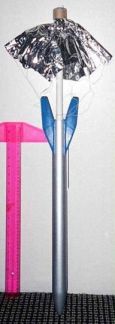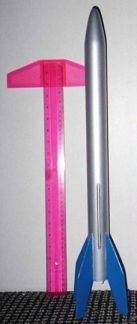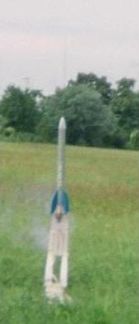| Manufacturer: | Modification |

 Brief:
Brief:
Big Bertha modified for rear ejection.
Modifications:
This is a Big Bertha modified so that the motor tube extends nearly the length of the body, and acts as a piston upon ejection. Recovery is nose first, making the rocket appear to be coming in upside down. I call it Ahtreb, which is Bertha backwards.
Essentially the motor mount assembly is not glued into the body tube, but it is allowed to slide freely (although not loosely) so that the motor tube slides backwards from the ejection charge and frees the parachute for recovery. The nose cone is glued to the body tube and acts as a bulkhead to keep the ejection charge from pushing forward. There is a small piece of BT-60 coupler that retains the motor mount from fully exiting the aft end of the body tube.
Construction:
Requires one Big Bertha kit of equivalent parts, plus:
- 12" of BT-20 coupler tube stock
- 4" of BT-60 coupler, cut into 3 pieces--1.5", 1.5", & 1"
- 2 20/50 centering rings
- 1 mylar chute kit
- Small piece of thin, flexible plastic or vinyl approx. 1/2" by 1"
The difficult part about this mod was making sure prior to any gluing that all steps were in the proper order. Getting anything out of order could have prevented completing the build.
Getting the thrust ring/piston stop glued strongly in the proper place without getting excess glue smeared in the tube that might prevent full travel of the piston took great care. Planning for all situations, including being prepared to reach in a very tight space and clean up excess glue, was essential.

Flight:
Preparing for flight means getting the chute and shrouds tucked inside the body before the aft end without getting them stuck between body and piston. Wrapping the chute with a sheet of paper, just as the protector used during building, makes this easy to get started. Then, after pulling out the paper, gently pushing the remaining chute and shrouds into the tube while working the piston forward, completes the process. No wadding is required; the piston protects the chute and shrouds from ejection gasses. At ejection, the piston moves from fully forward against the thrust ring to rearward, where air flow opens the chute. If the piston did not move fully back against the thrust ring, the deployment will force this.
First flight was on a B6-4. Boost was straight and just like an unmodified Bertha. Unfortunately, this was on a previous build using a plain BT-20 for the piston rather than BT-20 coupler stock. The was too thin and came apart in a spiral. Deployment was not correct but descent was still nose first and no damage other than the piston core occurred.
On the second build, the torn BT-20 was removed and BT20 coupler glued in its place.
Second flight was on a B6-4. The flight was good and this time deployment and descent were as planned.
Third flight was on a C6-3. Boost was the same as previous flights except higher, but deployment was very early, causing deployment at high speed and tearing the chute. Descent was still nose first and no other damage occurred.
Recovery:
The chute has been replaced (by cutting at the existing shroud connection points and around the center, and gluing a replacement into place in 2 pieces) and the rocket is ready for flight again. Medium to long delay engines are recommended so that deployment can occur at or after apogee, not before apogee.
Summary:
This is a complicated and difficult build but is a rewarding challenge for the experienced modeler. This ejection method could be repeated in builds of most mid- to large-diameter LPR birds.
#Related Reviews
- Modification Beg Bertha By Darren Longhorn
Beg Birtha Anyone remember Rocket Services? No? How about "Pitfield" motors? Ah, thought some of you might. Well, we don't see them around so much as in years gone by, but there are still a few around. In fact, I stumbled across a cache of them recently and thought I should ...
- Modification Big Bertha Payloader By Karl Upton
How To Convert An Estes Big Bertha Into A Payload Rocket Purpose and Design I need a series of payload rockets to carry experimental flight recorders/dataloggers into the Troposphere. The BBPC is something I came up with after a scratch-build payload rocket project that was enjoyable, but ...
- Modification Super Baby Bertha By Kevin Johnson
Took a Fat Boy kit and added Big Bertha like fins to make a Super Baby Bertha. Modifications: NARHAMS held a Fat Boy theme sport launch this month, and I was looking for something different to do with my last Fat Boy kit. I had just finished repairing my Super Big Bertha when inspiration ...
- Scratch 2x Big Bertha By David Fergus
This is a scratch 2X upscale of a popular Estes kit. It features a 3 inch diameter body and PML components (except the nose cone, which was turned on a lathe out of solid pine). It weighs 3.5 pounds and is 45 inches tall. A 36" long, 3" diameter quantum body tube was ordered with fin slots ...
- Scratch Big Bad Bertha By Bob Fortune
Big Bad Bertha Premise: Find out how bad Bertha can actually be. Fun Facts Just because your jaws are wired shut doesn't mean milkshakes aren't part of the food pyramid. That's not a stool she's sitting on. Starting point: Estes Big Bertha ...
Related Products
 |
 |